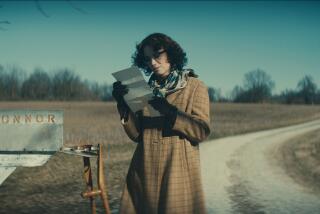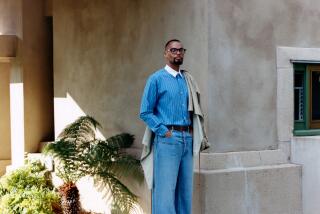The Memoir of a Legendary Friendship : A WOMAN ON PAPER Georgia O’Keeffe<i> by Anita Pollitzer; introduction by Kay Boyle (Touchstone: $24.95, cloth; $12.95, paper; 181 pp., illustrated) </i>
- Share via
Georgia O’Keeffe illustrated the landscape of the 20th-Century female psyche. We have learned to see ourselves in her work: single flowers ourselves unfolding in timeless space, multicolored mountains our flesh and our dreams, white bones our essence.
O’Keeffe showed us what it was like to be a woman, showed us where she lived and what she saw, and in the process, we recognize ourselves. She drew the places and things of her world and now we occupy her vision. We see her in the mind’s eye stalking the mesas and hills of northern New Mexico, flirting with Ansel Adams’ camera lens at the edge of Canyon de Chelly, naked, as her husband, Alfred Stieglitz, photographed her, leaning against the gate of her house in Abiquiu, or as I saw her when I visited her at home, sitting demurely underneath a mobile that Alexander Calder made for her, or wandering through her studio touching her works in progress.
For the record:
12:00 a.m. Sept. 18, 1988 FOR THE RECORD
Los Angeles Times Sunday September 18, 1988 Home Edition Book Review Page 11 Book Review Desk 1 inches; 19 words Type of Material: Correction
The portrait of Georgia O’Keeffe that appeared on Page 2 of Book Review on Sept. 4 was photographed by Ansel Adams, not by Alfred Stieglitz.
O’Keeffe is probably one of the few people that one can truly say was a legend in her own time. No woman artist has approximated her stature, few women her bearing, her singularity of purpose, her directness and constant devotion to her own way of seeing.
And now comes a book that tells us, often in her own words, how O’Keeffe sounded, how she got to where she was going and how she felt about the journey. It is a most remarkable book. “A Woman on Paper: Georgia O’Keeffe” by Anita Pollitzer is a dialogue, a woman’s memoir illustrated out of the fabric of two women’s lives. Pollitzer’s text, written in the present tense about O’Keeffe, provides an easy intimacy between the author and subject.
Pollitzer and O’Keeffe were art students together in New York, and in 1915 when O’Keeffe moved to South Carolina to teach, they began a correspondence and a friendship that lasted until Pollitzer died in 1975. Pollitzer was an artist, a lawyer, an organizer of the National Woman’s Party, a champion of the right to vote for women, an unselfish friend and the person who facilitated destiny when she took drawings that O’Keeffe had sent her for criticism to Stieglitz. It was Stieglitz who said when Pollitzer unrolled the drawings, “Woman is, at last, on paper, expressing her relation to the Universe.”
Stieglitz, a photographer, ran Gallery 291 in New York, supporting new art. Through his eye, he changed the perception of art in the United States from formalism to the modernity already evident in Europe. He showed Cezanne when he couldn’t find a buyer to pay $40 for one of the artist’s paintings. And he showed the work of O’Keeffe, loved her, photographed her as a woman has never been photographed before and eventually married her.
“A Woman on Paper” is a book of letters exchanged between Pollitzer and O’Keeffe and provides a rare look into the early private life of O’Keeffe and Stieglitz, of O’Keeffe’s relationships with early suitors, and with her work. It is illustrated with photographs of O’Keeffe by Stieglitz and others, of Pollitzer, of O’Keeffe’s paintings of Stieglitz himself, of notes, letters, invitations to shows, of the places where O’Keeffe and Stieglitz and Pollitzer spent time.
And it is a book that tells you that the voices of the most independent, far-seeing women of the times, the pioneers of women’s rights and visions talked to each other as gushing, enthusiastic, eager and confused schoolgirls straight out of the Victorian era--as they may not have talked with their men. They called each other “girls” and affectionate nicknames that would send some men and women today into diatribes on the importance and seriousness of being called women; somehow the women’s movement and women’s art thrived--proving that it is not language alone but integrity and vision that impel progress. In 1915, they wrote to each other:
O’Keeffe to Pollitzer: “Dear litttle Pollitzer--Don’t you like little spelled with three ts--but you are little you know and I like you little but I also like you a lot.”
Pollitzer to O’Keeffe: “Pat! such a letter--It was perfectly great and so good to get it--you write letters exactly like yourself, and I love them. . . .”
Pollitzer to O’Keeffe: “Oh Pat let’s swear--It helps so much--Write me your bad feelings if you like and your good ones when you get them. It may make me and you nearer.”
O’Keeffe to Pollitzer: 1916 “. . . Everything I do looks like dough--or the devil I don’t know which--and I don’t seem to be able to collect my wits enough to get anything done--and so I started to sew.”
The Georgia O’Keeffe whose voice is throughout “A Woman on Paper” was a unique mix of girl and woman. When I met her first in the early 1970s, she was exactly that same mix, swooning over her new young gardener and visioning the future of her work while making seemingly irreverent comments about her sometimes neighbor, Thomas Merton. And yet she was, and still is, the stark, colorful, distinguished, individualized representation of woman with little accouterment.
Pollitzer’s text reveals that in 1928, O’Keeffe was ill and that a doctor said she had not long to live. Another doctor advised her to live at her own pace and not at Stieglitz’s, running his large summer household in Lake George. In 1929, she went with Rebecca Strand, wife of the photographer Paul Strand, to New Mexico. Pollitzer says that although thousands of wives leave their husbands to take summer trips with less reason than saving one’s life, Stieglitz carried on to the entire art world as if life would end, as if the West were a lover stealing away his adored wife. Pollitzer says that O’Keeffe told her, “going West was the hardest decision I ever had to make.”
“A Woman on Paper” is a book that causes you to examine your own friendships, that makes you wish you would write letters to your friends instead of telephoning. It is a book that makes you long for a friend as loyal as Anita Pollitzer, a companion as headstrong, discerning and gifted as Georgia O’Keeffe. (It is also a book that tells you, by the dates on the letters, that mail service in the early part of this century was considerably faster than it is today.)
You will need more than your own copy of this book. Buy several for your closest friends. You’ll be offering them a work of art.
More to Read
Sign up for our Book Club newsletter
Get the latest news, events and more from the Los Angeles Times Book Club, and help us get L.A. reading and talking.
You may occasionally receive promotional content from the Los Angeles Times.









